[Retracted] Effectiveness of Oil Filling in Tight Sandstone Reservoirs of Yancheng Formation in Ordos Basin
Abstract
The Ordos basin is one of the important oil-bearing basins in China, with abundant tight sandstone oil resources, wide distribution, and large thickness. It is the most realistic field of unconventional oil and gas exploration in China, and it is also an important oil and gas replacement resource at present. Oil accumulation in tight reservoirs is obviously different from conventional oil and gas accumulation, and the key lies in studying the effectiveness of oil filling in tight reservoirs. In order to solve this problem, this paper takes the tight sandstone reservoir of Member 7 of the Yancheng Formation in Ordos Basin as the research object, introduces the geological characteristics of this area after sorting out the previous research results, carries out the physical simulation experiment of oil filling, studies the relationship between the filling pressure and the lower limit of the filling throat, analyzes the effective accumulation space of the tight sandstone reservoir, defines the oil filling mechanism of the tight sandstone reservoir, and discusses the effectiveness and reservoir-forming effect of oil filling in different types of reservoirs. The results show that the rock types of tight sandstone reservoirs in the 7th member of the Yancheng Formation are mainly lithic feldspathic sandstone and feldspathic lithic sandstone, and the reservoirs have experienced strong compaction and carbonate cementation. The late iron-bearing carbonate cementation has further strengthened the degree of reservoir densification, and the reservoirs have been densified at the time of large-scale oil and gas filling. Through the simulation experiment of oil filling with natural cores with different physical properties, the relationship model between filling pressure and effective accumulation space of different types of tight sandstone reservoirs in Member 7 of the Yancheng Formation is established. With the change in filling pressure, the change trend and range of effective accumulation space of different types of tight sandstone reservoirs are obviously different. According to the relationship model between the filling pressure and the lower limit of the effective filling pore throat, the oil filling effectiveness of different types of tight sandstone reservoirs in the 7th member of the Yancheng Formation is determined. Class I and class II1 reservoirs are effective reservoirs for oil filling of tight sandstone reservoirs, which constitute the main oil-bearing section of tight sandstone reservoirs in member 7 of the Yancheng formation, while class II2 reservoirs are poor tight reservoirs, and class III reservoirs are basically oil-free, which are noneffective reservoirs for oil filling of tight sandstone reservoirs. The results provide theoretical data support for the next step of oil exploration and exploitation in tight sandstone reservoirs.
1. Introduction
With the continuous growth of global oil and gas demand, conventional oil and gas production is declining, and the exploration and development of unconventional oil and gas resources are gradually being paid attention to and have become the main way to increase global oil and gas production. In China, tight sandstone reservoirs are widely distributed in the Ordos Basin, Junggar Basin, Sichuan Basin, Songliao Basin, and other major basins, which are rich in oil resources and have good exploration prospects [1–4]. The tight sandstone reservoir in the Ordos Basin is rich in oil resources, with a resource reserve of 30 × 108 t. The demonstration area of tight reservoir oil horizontal wells and Xin’anbian oilfield of 100 million tons have been built, which has achieved a major breakthrough in tight reservoir oil exploration in China [5–8]. The lacustrine tight sandstone reservoir in the 7th member of the Yanchang Formation has poor physical properties, a complex pore structure, and a widely developed micronano pore throat system, which has differences in the effectiveness of oil occurrence, resulting in strong heterogeneity of oil distribution in a tight sandstone reservoir. Therefore, it is of great significance for oil exploration and exploitation to study the oil occurrence state and oil filling effectiveness in tight sandstone reservoirs [9–12].
The tight sandstone of the Yanchang Formation in the Ordos Basin is a typical tight reservoir in China’s continental basins, which have considerable reserves and great exploration and development value. Scholars have conducted in-depth research on the oil filling characteristics and reservoir-forming mechanisms of tight sandstone reservoirs and achieved fruitful results [13–16]. Some researchers have mainly studied the dynamic conditions of oil migration and accumulation in tight sandstone reservoirs; the characteristics of oil seepage in tight sandstone reservoirs; and the lower limit of oil filling pore throat in tight sandstone reservoirs. Some researchers have suggested that the influence of pore structure on oil accumulation in tight reservoirs is mainly manifested in the effectiveness of oil filling and accumulation in micronano pore throat systems; that is, the lower limit of oil filling pore throat, which is the smallest throat diameter that oil can reach from source rock to reservoir under geological conditions [17–20]. Some researchers have studied clastic reservoirs with different grain sizes and determined the throat diameter distribution range of conventional and tight sandstone reservoirs and the diameter range of different organic molecules from asphaltene to methane, which provided a theoretical basis for the comparison of the pore throat distribution characteristics of different reservoirs, the critical pore throat conditions of oil filling, and the potential of fine-grained rocks as reservoirs. Some researchers put forward nano-scale oil and gas reservoir pores and theoretically calculated that the lower limit of critical pore throat for methane desorption (mobility) in tight sandstone gas reservoirs is 40 nm and the lower limit of tight sandstone oil occurrence pores is 54 nm [17, 21–23]. At the same time, the lower limit of oil-bearing pores in unconventional tight sandstone reservoirs is determined by scanning electron microscopy (SEM), which is 44∼58 nm. Based on the theory of fluid mechanics and the balance principle of reservoir-forming power and resistance, some researchers have calculated the lower limit of oil-filled pore throat at the source-reservoir interface and inside the reservoir of tight reservoirs in many basins and proved that the lower limit of oil-filled pore throat at the source-reservoir interface is generally smaller than that inside the reservoir [24–27]. Some researchers use the chloroform asphalt “a” obtained by the extraction method to establish a relationship with the average pore size of nitrogen adsorption, calculate the boundary between oil-bearing and nonoil-bearing pores on the intersection map, and calculate that the average lower limit of oil-bearing pores of the dense sandstone in member 7 of the Yancheng formation is 30 nm. Some researchers use various methods to study the lower limit of oil filling in tight sandstone reservoirs, which is mainly between 20 and 60 NM. At the same time, the lower limit of static pore throat where oil may exist does not consider the change of the lower limit of pore throat under different geological conditions; that is, there are certain differences between different filling pressures and the matching lower limit of filling pore throat.
The Ordos basin is one of the important oil-bearing basins in China, with abundant tight sandstone oil resources, wide distribution, and large thickness. Oil accumulation in tight sandstone reservoirs is obviously different from conventional oil and gas accumulation, and the key lies in studying the effectiveness of oil filling in tight reservoirs [28–31]. In this paper, taking the tight sandstone reservoir of Member 7 of the Yancheng Formation in the Ordos Basin as the research object, after sorting out the previous research results, the geological characteristics of this area are introduced, and the physical simulation experiment of oil filling is carried out. The relationship between filling pressure and the lower limit of filling pore throat is studied, the effective accumulation space of a tight sandstone reservoir is analyzed, the oil filling mechanism of a tight sandstone reservoir is defined, and the effectiveness and reservoir-forming efficiency of oil filling in tight sandstone reservoirs are discussed, which provides theoretical data support for oil exploration and exploitation in tight sandstone reservoirs [32].
2. Geological Characteristics of the Reservoir
2.1. General Situation of Reservoir Geology
The Ordos Basin is a large Meso-Cenozoic continental basin in Central China. It is a stable cratonic sedimentary basin with a total area of about 250,000 km2. The research area is located in the southwest of the Ordos Basin, starting from Huanxian County in the west, Taibai in the east, Zhengning in the south, and Dingbian in the north; structurally, it belongs to the southwest of the Yishan slope in the Ordos Basin and is connected with the Tianhuan depression. It is a west-dipping monocline with a dip angle of only half a degree and a nearly north-south direction. The nose-shaped uplift is developed locally, with an area of about 50000 km2, accounting for about 25% of the area of the Ordos Basin.
The Yancheng Formation studied in this paper is the first source-reservoir system developed after the formation of a large inland depression lake basin in the Ordos Basin. It is a sedimentary system of braided river delta, meandering river delta, and turbidite fan, which is mainly composed of medium-fine sandstone and mudstone. Oil shale is locally developed, including coal seam interlayer. There are 10 oil reservoirs in the Yancheng Formation from bottom to top, all of which are found. Among them, the 7th member of the Yancheng Formation (Table 1) is the peak period of lake basin development, and the average permeability of sandstone in oil reservoirs is less than 0.3 × 10−3 μm2, which is the typical reservoir in tight oil. The middle-lower Chang 73 submember is mainly a deep lacustrine facies, and its lithology is mainly mudstone and silty mudstone. Middle-upper Chang 71 and Chang 72 are mainly semideep lacustrine facies, and their lithology is mainly fine sandstone and siltstone.
| Characteristic | Lithology description | Thickness (m) |
|---|---|---|
| Yancheng group 71 | Thick fine sandstone and siltstone mixed with argillaceous siltstone and mudstone | 35∼45 m |
| Yancheng group 72 | Thick fine sandstone, thin siltstone interbedded with mudstone, and thick mudstone and muddy siltstone. | 25∼35 m |
| Yancheng group 73 | Black oil shale and occasionally thin tuff deposits. | 35∼45 m |
2.2. Petrological Characteristics of the Reservoir
The tight oil reservoir (Table 2) of the 7th member of the Yancheng Formation in Ordos has a fine grain size, mainly composed of fine sandstone, extremely fine sand, siltstone, and mudstone, which are well sorted as a whole, and most of the grains are subangular. The rock types are mainly lithic feldspathic sandstone and feldspathic lithic sandstone, followed by feldspathic sandstone. The reservoir detrital composition (Table 3) is mainly Shi Ying, feldspar and cuttings, among which the content of Shi Ying is the highest, and the content of cuttings in metamorphic rocks is the highest, reaching 40% of the rocks.
| Rock character | Fine sandstone | Very fine sand | Siltstone | Mudstone | Other |
|---|---|---|---|---|---|
| Proportion (%) | 60.3 | 10.1 | 7.2 | 9.3 | 13.1 |
| Composition classification | Composition | Diagenetic type | ||||
|---|---|---|---|---|---|---|
| Quartz | Feldspar | Debris | Metamorphic rock debris | Magmatic rock cuttings | Sedimentary cuttings | |
| Proportion (%) | 45.7 | 32.9 | 21.4 | 45 | 35 | 20 |
2.3. Hydrocarbon Accumulation Process
The Ordos basin has experienced four different degrees of tectonic uplift and stratum denudation since the deposition of the Yancheng Formation in the Late Triassic. Figure 1 shows the hydrocarbon accumulation process in the Ordos Basin. From the late Jurassic to the early Cretaceous, the buried depth of the source rocks in the 7th member of the Yancheng Formation was mostly distributed at 1000∼1500 m and they entered the hydrocarbon generation threshold to generate a small amount of oil, which was discharged from the source rocks and migrated to the adjacent favorable reservoirs, forming the early small-scale oil filling. At the end of the early Cretaceous (110∼100 ma), the buried depth of strata was the highest, and it began to enter the peak of hydrocarbon generation, generating a large number of liquid hydrocarbons, which were injected into tight sandstone reservoirs on a large scale, forming oil accumulation in tight sandstone reservoirs of Member 7 of the Yancheng Formation. The temperature measurement of core fluid inclusions shows that the average temperature of salt water inclusions corresponding to small-scale reservoir formation in early tight sandstone reservoirs is 70∼90°C, and the average degree of saltwater inclusions corresponding to the main filling period of petroleum in late tight sandstone reservoirs is 90∼115°C.
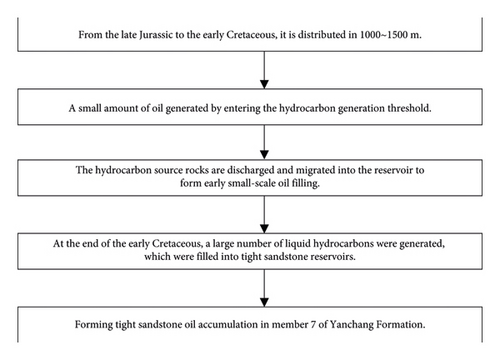
2.4. Physical Simulation Experiment of Oil Filling
In this paper, the NMR fluid displacement equipment of the Institute of Geology and Geophysics, Chinese Academy of Sciences, is adopted, which consists of a fluid injection system, fluid displacement system, NMR imaging system, and a computer data processing system. The fluid injection system is composed of a constant pressure and constant speed displacement pump, a ring pressure pump, and a temperature and pressure sensor, which provide axial pressure (filling pressure) and apply ring pressure to the whole system. The fluid displacement system consists of a high-pressure core holder and an intermediate container. The ring pressure of the core holder is controlled by a ring pressure pump, and the maximum axial pressure can reach 30 MPa during the experiment. A nuclear magnetic resonance imaging system is composed of nuclear magnetic resonance instruments, mainly including fluid detection units and data imaging units, which can detect the fluid in the rock core online. The main resonance frequency of the NMR instrument is 10 MHz, the waiting time is 3000 ms, the echo time is 0.2 ms, the number of scans is 64, the number of echoes is 4200, and the magnet temperature is 25°C. The whole displacement equipment is controlled by the computer data processing system. In the experiment, the lateral relaxation time spectrum of the fluid is measured once every 3 minutes to monitor the oil filling process (oil displacement water) in real time.
In the experiment, natural tight sandstone core samples are used to carry out filling simulation experiments. The basic physical parameters of the samples are shown in Table 4. The experimental displacement device adopts an axial pressure of 1, 4, 8, 12, 16, and 20 MPa, and a certain confining pressure (up to 30 MPa) is set. Simulated formation oil (3# white oil) or Chang 7 crude oil is used to displace the core plunger saturated with simulated formation water, simulating the filling process of petroleum in tight reservoirs, and identifying the fluid by means of nuclear magnetic resonance T2 spectrum. The core samples selected in the experiment are mainly distributed in the distribution area of tight sandstone oil core and have a certain physical property gradient.
| Sample number | Depth | Average diameter/mm | Average length/mm | Permeability/mD | Porosity/% | Simulated oil | Reservoir type | Horizon |
|---|---|---|---|---|---|---|---|---|
| YC-1 | 1741 | 25.31 | 49.98 | 0.0218 | 9.56 | 3# white oil | II2 | Long 7 |
| YC-2 | 2015 | 25.62 | 50.15 | 0.0398 | 10.41 | 3# white oil | II2 | Long 7 |
| YC-3 | 1720 | 25.72 | 50.27 | 0.0653 | 11.04 | 3# white oil | II1 | Long 7 |
| YC-4 | 2020 | 24.89 | 50.42 | 0.0757 | 10.18 | 3# white oil | II1 | Long 7 |
| YC-5 | 1929 | 25.05 | 50.08 | 0.1485 | 9.51 | 3# white oil | I | Long 7 |
| YC-6 | 2082 | 25.02 | 50.19 | 0.4259 | 12.26 | 3# white oil | I | Long 7 |
| YC-7 | 2015 | 25.41 | 49.87 | 0.0163 | 7.37 | Crude oil | III | Long 7 |
| YC-8 | 1728 | 25.11 | 50.45 | 0.1270 | 10.19 | Crude oil | II1 | Long 7 |
Figure 2 Shows the physical simulation experiment process of petroleum filling. In the experiment, the core was evacuated at 105°C for 24 hours, at −0.098 MPa for 24 hours, and pressurized at 30 MPa for 48 hours, and the simulated saturated manganese ions were more than 20000 ppm. During the experiment, the NMR signal (T2 spectrum of the oil phase) was measured online every 3 minutes. When the T2 spectrum remained stable for a long time (i.e., oil saturation remained unchanged), the axial pressure was increased and the filling experiment was continued until it was stable under the maximum pressure.
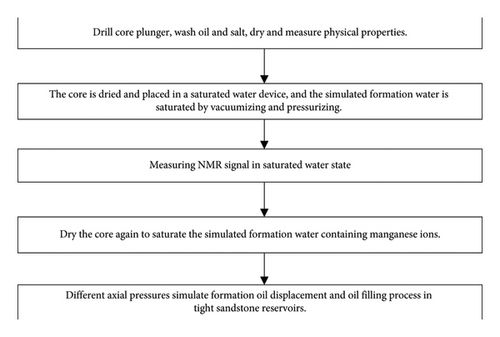
3. Filling Effectiveness of Tight Sandstone Reservoir
3.1. Test Results
Through the physical simulation experiment of oil filling, the relationship between filling pressure and oil saturation is obtained. The oil saturation of simulated oil gradually increases with the increase of filling pressure, but there are some differences in the changing trends of different oil saturations with filling pressure, which is mainly due to the differences in physical properties and pore structures of rock samples, as well as the properties of white oil and crude oil. Under the condition of white oil filling, the increasing trend of oil saturation can be roughly divided into three types: gradually increasing type (Figure 3), gradually increasing-stabilizing type (Figure 4) and rapidly increasing-slowly increasing type (Figure 5).
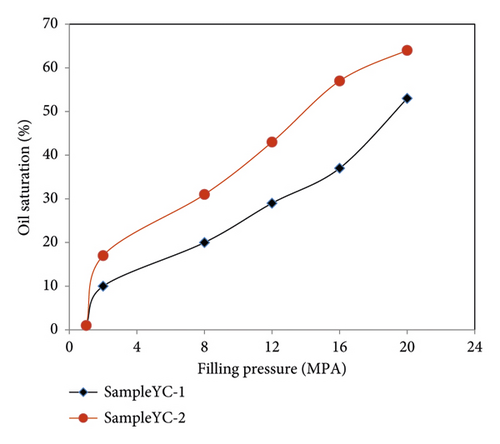
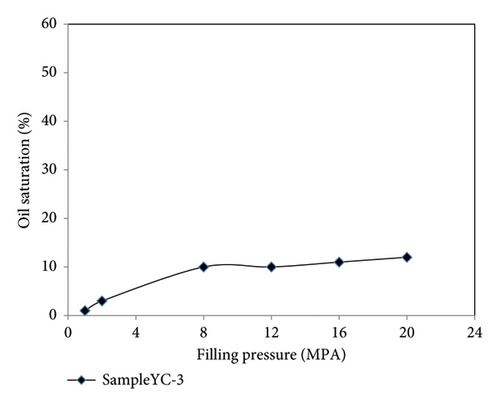
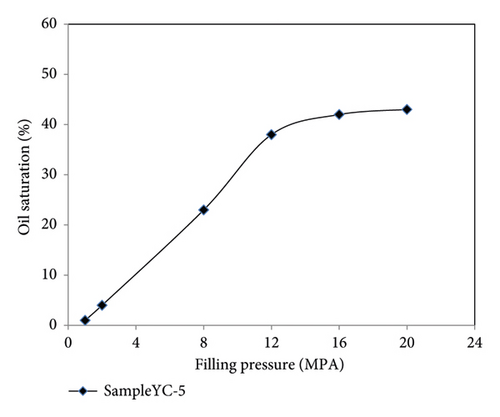
Gradually increasing type means that the growth rate of oil saturation basically keeps constant with the increase of filling pressure, mainly for samples YC-1 and YC-2. The physical properties and pore structure of the two samples are not significantly different, but the oil saturation growth rate and final oil saturation of sample YC-2 are higher than those of sample YC-1, and the oil saturation is at least 10% higher. When the filling pressure is increased from 16 MPa to 20 MPa, the oil saturation of sample YC-1 increases more than that of sample YC-2, which is mainly related to the local wettability change of the sample.
Gradually increasing-stabilizing type means that the growth rate of oil saturation generally decreases gradually and finally tends to zero, and sample YC-3 is typical. When the filling pressure is lower than 8 MPa, the oil saturation gradually increases with the increase of the filling pressure; when the filling pressure is greater than 8 MPa, with the increase of the filling pressure, the growth rate of oil saturation gradually decreases, and finally the oil saturation tends to be stable.
The rapid growth-slow growth type means that the oil saturation growth rate at low filling pressure is obviously higher than that at high filling pressure, mainly including samples YC-4, YC-5, and YC-6. When the filling pressure is less than 4 MPa, the oil saturation increases rapidly with the increase of the filling pressure, up to 40%. When the filling pressure is greater than 4 MPa, the increase in oil saturation is obviously slowed down with the increase of the filling pressure. Within the filling pressure span of 4 MPa to 20 MPa, the oil saturation increases by about 25%.
3.2. Filling Effectiveness of Tight Sandstone Reservoir
In the process of oil accumulation in tight sandstone reservoirs, the filling pressure required to reach a certain oil saturation is complementary to the pore throat size, that is, the sample with a small pore throat radius needs a higher filling pressure, while the sample with a large pore throat radius needs a lower filling pressure. Therefore, to reach the lower limit of oil saturation, physical properties (especially permeability) and filling pressure are complementary. When the oil saturation of a tight sandstone reservoir reaches 30%∼40%, oil accumulation is formed. The simulation experiment shows that the filling pressure can increase the oil saturation of the reservoir to a certain extent. Tight sandstone reservoirs with different compactness require different filling pressures to reach the lower limit of oil saturation. The denser the reservoir, the higher the filling pressure. Through the comparison of experimental samples, the II2 reservoirs represented by samples YC-1 and YC-2 can reach the lower limit of reservoir formation when the filling pressure is 12∼16 MPa; The lower limit of reservoir-forming power of II1 reservoirs represented by samples YC-3 and YC-4 is about 4∼8 MPa; The lower limit of reservoir-forming power for II1 reservoirs represented by YC-5 and YC-6 samples with lower densification degree is only about 1∼4 MPa. When the degree of reservoir densification is too high, the capillary force resistance is too large. Under certain geological conditions, the filling pressure is no longer the sufficient condition for reservoir formation. For example, the oil saturation of sample yc-7 is only 11% under the filling pressure of 20 MPa, and the type III tight sandstone reservoir represented by it is impossible to form reservoirs. Therefore, it can be considered that the filling pressure and pore throat capillary resistance jointly determine the oil saturation growth process of tight sandstone oil and gas. In the process of oil filling and accumulation in the actual tight reservoir, the coupling of reservoir-forming power (overpressure of source rock) and reservoir-forming resistance (capillary force) controls the oil filling and retention in the tight reservoir.
According to the analysis of reservoir formation and filling effectiveness of four different types of tight sandstone reservoirs in the 7th member of the Yancheng Formation, it can be seen that the effective reservoir space of Class I is 69%∼85%, with an average of 76%. The effective accumulation space is obviously higher than the lower limit of oil saturation, an oil enrichment degree. When the filling pressure is not less than 10 MPa, this kind of reservoir is rich in oil and is a high-quality tight reservoir. The pore throat radius that this kind of reservoir needs to break through in order to reach the oil enrichment degree ranges from 0.18 to 0.67 μm, with an average of 0.37 μm, which is obviously higher than the lower limit of pore throat radius (0.094 μm), so the oil saturation of this kind of reservoir is often higher than 60%. In actual exploration, Class I reservoir is the best part of the “sweet spot” of a tight sandstone reservoir.
Class II reservoir is an effective tight reservoir, and its effective accumulation space is distributed in 50%∼84%, with an average of 59%. The effective accumulation space is obviously higher than the lower limit of oil saturation, in which the effective reservoir space of some rocks is over 60%, and this kind of reservoir is widely distributed, so this kind of reservoir is the main tight sandstone oil reservoir in the 7th member of the Yancheng Formation. To reach the oil saturation value of the reservoir, the pore throat radius of oil breakthrough is 0.11∼0.26 μm, with an average of 0.16 μm, which is obviously higher than the lower limit of pore throat radius (0.094 μm), so its oil saturation is obviously higher than 40%. The pore throat radius that this kind of reservoir needs to break through in order to enrich oil is distributed in the range of 0.04∼0.17 μm, with an average of 0.09 μm, which is close to the lower limit of pore throat radius for reservoir formation, so the oil content of some reservoirs may reach 60%, that is, the reservoir is enriched with oil.
Class II reservoirs are poor-tight reservoirs. The effective accumulation space of a reservoir ranges from 33% to 62%, with an average of 41.8%. The effective reservoir space basically swings up and down at the oil saturation value of the reservoir formation, in which some rocks can form reservoirs, but the oil saturation is generally low, so the oil content of these kinds of reservoirs can hardly reach the enrichment degree. In order to reach the oil saturation value of the reservoir, the pore throat radius of oil breakthrough ranges from 0.075 to 0.153 μm, with an average of 0.11 μm, which is slightly higher than the lower limit value of the pore throat radius of the reservoir formation. The pore throat radius that this kind of reservoir needs to break through in order to enrich oil ranges from 0.026 to 0.101 μm, with an average of 0.056 μm, which is obviously small.
Class III reservoir is a noneffective tight reservoir. The effective accumulation space of the reservoir ranges from 2% to 34%, with an average of 10.1%. When the reservoir reaches the lower limit of oil saturation, the pore throat radius of oil breakthrough ranges from 0.008 to 0.079 μm, with an average of 0.031 μm, far less than the lower limit of pore throat radius of the reservoir formation. Under geological conditions, the possible oil saturation of this kind of reservoir is basically less than 20%, which is far less than the lower limit of reservoir-forming saturation. Therefore, Class III reservoirs are ineffective reservoirs for oil accumulation.
To sum up, Class I and II1 reservoirs are effective reservoirs for oil filling and accumulation in tight sandstone reservoirs, which constitute the most important oil-bearing interval of tight sandstone oil in member 7 of the Yancheng Formation, and are the most realistic part for oil exploration and development in tight sandstone reservoirs. However, a Class III reservoir is basically oil-free, while a Class II2 reservoir is a poor tight reservoir, which is a noneffective oil accumulation reservoir of tight sandstone reservoir.
4. Conclusion
- (1)
The rock types of tight sandstone reservoirs in the 7th member of the Yancheng Formation are mainly lithic feldspathic sandstone and feldspathic lithic sandstone. The reservoirs have experienced strong compaction and carbonate cementation, and the late iron-bearing carbonate cementation has further strengthened the degree of reservoir densification. At the time of large-scale oil and gas filling, the reservoirs have been densified. Through the simulation experiment of oil filling with natural cores with different physical properties, the relationship model between filling pressure and effective accumulation space of different types of tight sandstone reservoirs in member 7 of Yancheng Formation is established. With the change in filling pressure, the change trend and range of effective accumulation space of different types of tight sandstone reservoirs are obviously different.
- (2)
According to the relationship model between filling pressure and the lower limit of effective filling pore throat, combined with the evolution results of source and reservoir pressure in the study area, it is determined that the lower limit of effective filling pore throat radius of a tight sandstone reservoir in Member 7 of the Yancheng Formation in the study area is about 0.1 μm·m. On this basis, the effectiveness of oil filling in different types of tight sandstone reservoirs in the 7th member of the Yancheng Formation is clarified: Class I and II1 reservoirs are effective reservoirs for oil filling in tight sandstone reservoirs, which constitute the most important oil-bearing section of tight sandstone reservoirs in the 7th member of the Yancheng Formation and are the most realistic part of oil exploration and development in tight sandstone reservoirs. However, the II2 reservoir is a poor tight reservoir, and the III reservoir is basically oil-free, both of which are noneffective reservoirs filled with oil in tight sandstone reservoirs.
Conflicts of Interest
The authors declare that they have no conflicts of interest.
Acknowledgments
The authors would like to show sincere thanks to those techniques who have contributed to this research.
Open Research
Data Availability
The figures and tables used to support the findings of this study are included in the article.




